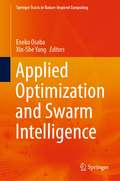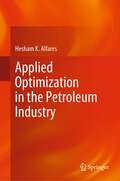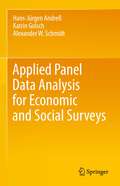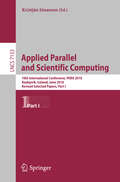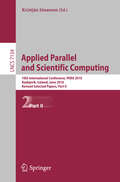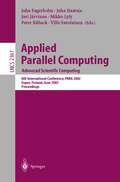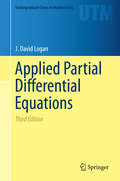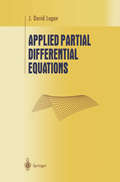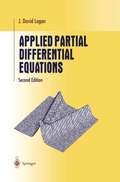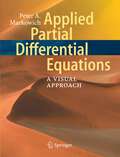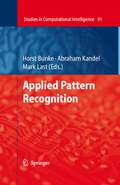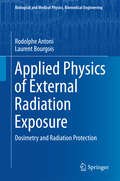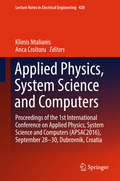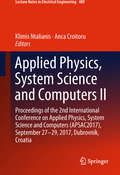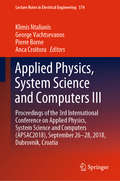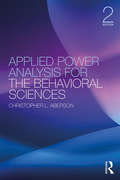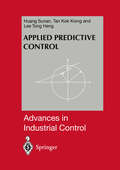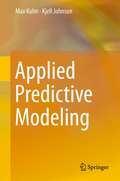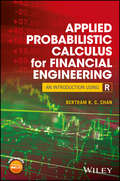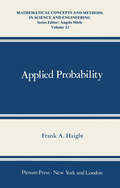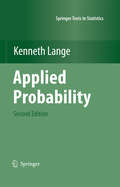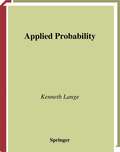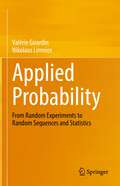- Table View
- List View
Applied Optimization and Swarm Intelligence (Springer Tracts in Nature-Inspired Computing)
by Eneko Osaba Xin-She YangThis book gravitates on the prominent theories and recent developments of swarm intelligence methods, and their application in both synthetic and real-world optimization problems. The special interest will be placed in those algorithmic variants where biological processes observed in nature have underpinned the core operators underlying their search mechanisms. In other words, the book centers its attention on swarm intelligence and nature-inspired methods for efficient optimization and problem solving. The content of this book unleashes a great opportunity for researchers, lecturers and practitioners interested in swarm intelligence, optimization problems and artificial intelligence.
Applied Optimization in the Petroleum Industry
by Hesham K. AlfaresThe book addresses optimization in the petroleum industry from a practical, large-scale-application-oriented point of view. The models and techniques presented help to optimize the limited resources in the industry in order to maximize economic benefits, ensure operational safety, and reduce environmental impact. The book discusses several important real-life applications of optimization in the petroleum industry, ranging from the scheduling of personnel time to the blending of gasoline. It covers a wide spectrum of relevant activities, including drilling, producing, maintenance, and distribution. The text begins with an introductory overview of the petroleum industry and then of optimization models and techniques. The main body of the book details a variety of applications of optimization models and techniques within the petroleum industry.Applied Optimization in the Petroleum Industry helps readers to find effective optimization-based solutions to their own practical problems in a large and important industrial sector, still the main source of the world’s energy and the source of raw materials for a wide variety of industrial and consumer products.
Applied Panel Data Analysis for Economic and Social Surveys
by Hans-Jürgen Andreß Katrin Golsch Alexander W. SchmidtMany economic and social surveys are designed as panel studies, which provide important data for describing social changes and testing causal relations between social phenomena. This textbook shows how to manage, describe, and model these kinds of data. It presents models for continuous and categorical dependent variables, focusing either on the level of these variables at different points in time or on their change over time. It covers fixed and random effects models, models for change scores and event history models. All statistical methods are explained in an application-centered style using research examples from scholarly journals, which can be replicated by the reader through data provided on the accompanying website. As all models are compared to each other, it provides valuable assistance with choosing the right model in applied research. The textbook is directed at master and doctoral students as well as applied researchers in the social sciences, psychology, business administration and economics. Readers should be familiar with linear regression and have a good understanding of ordinary least squares estimation.
Applied Parallel and Scientific Computing: 10th International Conference, PARA 2010, Reykjavík, Iceland, June 6-9, 2010, Revised Selected Papers, Part I (Lecture Notes in Computer Science #7133)
by Kristján JónassonThe two volume set LNCS 7133 and LNCS 7134 constitutes the thoroughly refereed post-conference proceedings of the 10th International Conference on Applied Parallel and Scientific Computing, PARA 2010, held in Reykjavík, Iceland, in June 2010. These volumes contain three keynote lectures, 29 revised papers and 45 minisymposia presentations arranged on the following topics: cloud computing, HPC algorithms, HPC programming tools, HPC in meteorology, parallel numerical algorithms, parallel computing in physics, scientific computing tools, HPC software engineering, simulations of atomic scale systems, tools and environments for accelerator based computational biomedicine, GPU computing, high performance computing interval methods, real-time access and processing of large data sets, linear algebra algorithms and software for multicore and hybrid architectures in honor of Fred Gustavson on his 75th birthday, memory and multicore issues in scientific computing - theory and praxis, multicore algorithms and implementations for application problems, fast PDE solvers and a posteriori error estimates, and scalable tools for high performance computing.
Applied Parallel and Scientific Computing: 10th International Conference, PARA 2010, Reykjavík, Iceland, June 6-9, 2010, Revised Selected Papers, Part II (Lecture Notes in Computer Science #7134)
by Kristján JónassonThe two volume set LNCS 7133 and LNCS 7134 constitutes the thoroughly refereed post-conference proceedings of the 10th International Conference on Applied Parallel and Scientific Computing, PARA 2010, held in Reykjavík, Iceland, in June 2010. These volumes contain three keynote lectures, 29 revised papers and 45 minisymposia presentations arranged on the following topics: cloud computing, HPC algorithms, HPC programming tools, HPC in meteorology, parallel numerical algorithms, parallel computing in physics, scientific computing tools, HPC software engineering, simulations of atomic scale systems, tools and environments for accelerator based computational biomedicine, GPU computing, high performance computing interval methods, real-time access and processing of large data sets, linear algebra algorithms and software for multicore and hybrid architectures in honor of Fred Gustavson on his 75th birthday, memory and multicore issues in scientific computing - theory and praxis, multicore algorithms and implementations for application problems, fast PDE solvers and a posteriori error estimates, and scalable tools for high performance computing.
Applied Parallel Computing: 6th International Conference, PARA 2002, Espoo, Finland, June 15-18, 2002. Proceedings (Lecture Notes in Computer Science #2367)
by Juha Fagerholm Juha Haataja Jari Järvinen Mikko Lyly Peter Raback Ville SavolainenApplied Partial Differential Equations (Undergraduate Texts in Mathematics #89)
by J. David LoganThis textbook is for the standard, one-semester, junior-senior course that often goes by the title "Elementary Partial Differential Equations" or "Boundary Value Problems". The audience consists of students in mathematics, engineering, and the sciences. The topics include derivations of some of the standard models of mathematical physics and methods for solving those equations on unbounded and bounded domains, and applications of PDE's to biology. The text differs from other texts in its brevity; yet it provides coverage of the main topics usually studied in the standard course, as well as an introduction to using computer algebra packages to solve and understand partial differential equations.For the 3rd edition the section on numerical methods has been considerably expanded to reflect their central role in PDE's. A treatment of the finite element method has been included and the code for numerical calculations is now written for MATLAB. Nonetheless the brevity of the text has been maintained. To further aid the reader in mastering the material and using the book, the clarity of the exercises has been improved, more routine exercises have been included, and the entire text has been visually reformatted to improve readability.
Applied Partial Differential Equations (Undergraduate Texts in Mathematics)
by J. David LoganThis textbook is for the standard, one-semester, junior-senior course that often goes by the title "Elementary Partial Differential Equations" or "Boundary Value Problems;' The audience usually consists of stu dents in mathematics, engineering, and the physical sciences. The topics include derivations of some of the standard equations of mathemati cal physics (including the heat equation, the· wave equation, and the Laplace's equation) and methods for solving those equations on bounded and unbounded domains. Methods include eigenfunction expansions or separation of variables, and methods based on Fourier and Laplace transforms. Prerequisites include calculus and a post-calculus differential equations course. There are several excellent texts for this course, so one can legitimately ask why one would wish to write another. A survey of the content of the existing titles shows that their scope is broad and the analysis detailed; and they often exceed five hundred pages in length. These books gen erally have enough material for two, three, or even four semesters. Yet, many undergraduate courses are one-semester courses. The author has often felt that students become a little uncomfortable when an instructor jumps around in a long volume searching for the right topics, or only par tially covers some topics; but they are secure in completely mastering a short, well-defined introduction. This text was written to proVide a brief, one-semester introduction to partial differential equations.
Applied Partial Differential Equations (Undergraduate Texts in Mathematics #89)
by J. David LoganThis text is written for the standard, one-semester, undergraduate course in elementary partial differential equations. The topics include derivations of some of the standard equations of mathematical physics (including the heat equation, the wave equation, and Laplace's equation) and methods for solving those equations on bounded and unbounded domains. Methods include eigenfunction expansions, or separation of variables, and methods based on Fourier and Laplace transforms.
Applied Partial Differential Equations: A Visual Approach
by Peter MarkowichThis book presents topics of science and engineering which occur in nature or are part of daily life. It describes phenomena which are modelled by partial differential equations, relating to physical variables like mass, velocity and energy, etc. to their spatial and temporal variations. The author has chosen topics representing his career-long interests, including the flow of fluids and gases, granular flows, biological processes like pattern formation on animal skins, kinetics of rarified gases and semiconductor devices. Each topic is presented in its scientific or engineering context, followed by an introduction of applicable mathematical models in the form of partial differential equations.
Applied Pattern Recognition (Studies in Computational Intelligence #91)
by Horst Bunke Abraham Kandel Mark LastA sharp increase in the computing power of modern computers has triggered the development of powerful algorithms that can analyze complex patterns in large amounts of data within a short time period. Consequently, it has become possible to apply pattern recognition techniques to new tasks. The main goal of this book is to cover some of the latest application domains of pattern recognition while presenting novel techniques that have been developed or customized in those domains.
Applied Physics of External Radiation Exposure: Dosimetry and Radiation Protection (Biological and Medical Physics, Biomedical Engineering)
by Rodolphe Antoni Laurent BourgoisThis book describes the interaction of living matter with photons, neutrons, charged particles, electrons and ions. The authors are specialists in the field of radiation protection. The book synthesizes many years of experiments with external radiation exposure in the fields of dosimetry and radiation shielding in medical, industrial and research fields. It presents the basic physical concepts including dosimetry and offers a number of tools to be used by students, engineers and technicians to assess the radiological risk and the means to avoid them by calculating the appropriate shields. The theory of radiation interaction in matter is presented together with empirical formulas and abacus. Numerous numerical applications are treated to illustrate the different topics. The state of the art in radiation protection and dosimetry is presented in detail, especially in the field of simulation codes for external exposure to radiation, medical projects and advanced research. Moreover, important data spread in different up to date references are presented in this book. The book deals also with accelerators, X-rays facilities, sealed sources, dosimetry, Monte Carlo simulation and radiation regulation. Each chapter is split in two parts depending on the level of details the readers want to focus on. The first part, accessible to a large public, provides a lot of simple examples to help understanding the physics concepts under radiation external exposure. The second part, called “Additional Information” is not mandatory; it aims on explaining topics more deeply, often using mathematical formulations. The book treats fundamental radiometric and dosimetric quantities to describe the interaction in materials under the aspects of absorbed dose processes in tissues. Definitions and applications on limited and operational radiation protection quantities are given. An important aspect are practical engineering tools in industrial, medical and research domains. Source characterization and shielding design are addressed. Also more ”exotic” topics, such as ultra intense laser and new generation accelerators, are treated. The state of the art is presented to help the reader to work with the book in a self-consistent way. The basic knowledge necessary to apply Monte Carlo methods in the field of radiation protection and dosimetry for external radiation exposure is provided. Coverage of topics such as variance reduction, pseudo-random number generation and statistic estimators make the book useful even to experienced Monte Carlo practitioners. Solved problems help the reader to understand the Monte Carlo process. The book is meant to be used by researchers, engineers and medical physicist. It is also valuable to technicians and students.
Applied Physics, System Science and Computers: Proceedings of the 1st International Conference on Applied Physics, System Science and Computers (APSAC2016), September 28-30, Dubrovnik, Croatia (Lecture Notes in Electrical Engineering #428)
by Klimis Ntalianis Anca CroitoruThis book reports on advanced theories and methods in three related fields of research: applied physics, system science and computers. It is organized in two main parts, the first of which covers applied physics topics, including lasers and accelerators; condensed matter, soft matter and materials science; nanoscience and quantum engineering; atomic, molecular, optical and plasma physics; as well as nuclear and high-energy particle physics. It also addresses astrophysics, gravitation, earth and environmental science, as well as medical and biological physics. The second part focuses on advances in system science and computers, exploring automatic circuit control, power systems, computer communication, fluid mechanics, simulation and modeling, software engineering, data structures and applications of artificial intelligence among other areas. Offering a collection of contributions presented at the 1st International Conference on Applied Physics, System Science and Computers (APSAC 2016), the book bridges the gap between applied physics and electrical engineering. It not only to presents new methods, but also promotes collaborations between different communities working on related topics at the interface between physics and engineering, with a special focus on communication, data modeling and visualization, quantum information, applied mechanics as well as bio and geophysics.
Applied Physics, System Science and Computers II: Proceedings of the 2nd International Conference on Applied Physics, System Science and Computers (APSAC2017), September 27-29, 2017, Dubrovnik, Croatia (Lecture Notes in Electrical Engineering #489)
by Klimis Ntalianis Anca CroitoruThis book reports on advanced theories and methods in three related fields of research: applied physics, system science and computers. It is organized in three parts, the first of which covers applied physics topics, including lasers and accelerators; condensed matter, soft matter and materials science; nanoscience and quantum engineering; atomic, molecular, optical and plasma physics; as well as nuclear and high-energy particle physics. It also addresses astrophysics, gravitation, earth and environmental science, as well as medical and biological physics. The second and third parts focus on advances in computers and system science, respectively, and report on automatic circuit control, power systems, computer communication, fluid mechanics, simulation and modeling, software engineering, data structures and applications of artificial intelligence among other areas. Offering a collection of contributions presented at the 2nd International Conference on Applied Physics, System Science and Computers (APSAC), held in Dubrovnik, Croatia on September 27–29, 2017, the book bridges the gap between applied physics and electrical engineering. It not only to presents new methods, but also promotes collaborations between different communities working on related topics at the interface between physics and engineering, with a special focus on communication, data modeling and visualization, quantum information, applied mechanics as well as bio and geophysics.
Applied Physics, System Science and Computers III: Proceedings of the 3rd International Conference on Applied Physics, System Science and Computers (APSAC2018), September 26-28, 2018, Dubrovnik, Croatia (Lecture Notes in Electrical Engineering #574)
by Klimis Ntalianis George Vachtsevanos Pierre Borne Anca CroitoruThis book reports on advanced theories and methods in three related fields of research: applied physics, system science and computers. The first part covers applied physics topics, such as lasers and accelerators; fluid dynamics, optics and spectroscopy, among others. It also addresses astrophysics, security, and medical and biological physics. The second part focuses on advances in computers, such as those in the area of social networks, games, internet of things, deep learning models and more. The third part is especially related to systems science, covering swarm intelligence, smart cities, complexity and more. Advances in and application of computer communication, artificial intelligence, data analysis, simulation and modeling are also addressed. The book offers a collection of contributions presented at the 3nd International Conference on Applied Physics, System Science and Computers (APSAC), held in Dubrovnik, Croatia on September 26–28, 2018. Besides presenting new methods, it is also intended to promote collaborations between different communities working on related topics at the interface between physics, computer science and engineering.
Applied Power Analysis for the Behavioral Sciences: 2nd Edition
by Christopher L. AbersonApplied Power Analysis for the Behavioral Sciences is a practical "how-to" guide to conducting statistical power analyses for psychology and related fields. The book provides a guide to conducting analyses that is appropriate for researchers and students, including those with limited quantitative backgrounds. With practical use in mind, the text provides detailed coverage of topics such as how to estimate expected effect sizes and power analyses for complex designs. The topical coverage of the text, an applied approach, in-depth coverage of popular statistical procedures, and a focus on conducting analyses using R make the text a unique contribution to the power literature. To facilitate application and usability, the text includes ready-to-use R code developed for the text. An accompanying R package called pwr2ppl (available at https://github.com/chrisaberson/pwr2ppl) provides tools for conducting power analyses across each topic covered in the text.
Applied Power Analysis for the Behavioral Sciences: 2nd Edition
by Christopher L. AbersonApplied Power Analysis for the Behavioral Sciences is a practical "how-to" guide to conducting statistical power analyses for psychology and related fields. The book provides a guide to conducting analyses that is appropriate for researchers and students, including those with limited quantitative backgrounds. With practical use in mind, the text provides detailed coverage of topics such as how to estimate expected effect sizes and power analyses for complex designs. The topical coverage of the text, an applied approach, in-depth coverage of popular statistical procedures, and a focus on conducting analyses using R make the text a unique contribution to the power literature. To facilitate application and usability, the text includes ready-to-use R code developed for the text. An accompanying R package called pwr2ppl (available at https://github.com/chrisaberson/pwr2ppl) provides tools for conducting power analyses across each topic covered in the text.
Applied Predictive Control (Advances in Industrial Control)
by Sunan Huang Tong Heng LeeThis focused treatment includes the fundamentals and some state-of-the-art developments in the field of predictive control. A substantial part of the book addresses application issues in predictive control, providing several interesting case studies for more application-oriented readers.
Applied Predictive Modeling
by Max Kuhn Kjell JohnsonApplied Predictive Modeling covers the overall predictive modeling process, beginning with the crucial steps of data preprocessing, data splitting and foundations of model tuning. The text then provides intuitive explanations of numerous common and modern regression and classification techniques, always with an emphasis on illustrating and solving real data problems. The text illustrates all parts of the modeling process through many hands-on, real-life examples, and every chapter contains extensive R code for each step of the process. This multi-purpose text can be used as an introduction to predictive models and the overall modeling process, a practitioner’s reference handbook, or as a text for advanced undergraduate or graduate level predictive modeling courses. To that end, each chapter contains problem sets to help solidify the covered concepts and uses data available in the book’s R package.This text is intended for a broad audience as both an introduction to predictive models as well as a guide to applying them. Non-mathematical readers will appreciate the intuitive explanations of the techniques while an emphasis on problem-solving with real data across a wide variety of applications will aid practitioners who wish to extend their expertise. Readers should have knowledge of basic statistical ideas, such as correlation and linear regression analysis. While the text is biased against complex equations, a mathematical background is needed for advanced topics.
Applied Probabilistic Calculus for Financial Engineering: An Introduction Using R
by Bertram K. ChanIllustrates how R may be used successfully to solve problems in quantitative finance Applied Probabilistic Calculus for Financial Engineering: An Introduction Using R provides R recipes for asset allocation and portfolio optimization problems. It begins by introducing all the necessary probabilistic and statistical foundations, before moving on to topics related to asset allocation and portfolio optimization with R codes illustrated for various examples. This clear and concise book covers financial engineering, using R in data analysis, and univariate, bivariate, and multivariate data analysis. It examines probabilistic calculus for modeling financial engineering—walking the reader through building an effective financial model from the Geometric Brownian Motion (GBM) Model via probabilistic calculus, while also covering Ito Calculus. Classical mathematical models in financial engineering and modern portfolio theory are discussed—along with the Two Mutual Fund Theorem and The Sharpe Ratio. The book also looks at R as a calculator and using R in data analysis in financial engineering. Additionally, it covers asset allocation using R, financial risk modeling and portfolio optimization using R, global and local optimal values, locating functional maxima and minima, and portfolio optimization by performance analytics in CRAN. Covers optimization methodologies in probabilistic calculus for financial engineering Answers the question: What does a "Random Walk" Financial Theory look like? Covers the GBM Model and the Random Walk Model Examines modern theories of portfolio optimization, including The Markowitz Model of Modern Portfolio Theory (MPT), The Black-Litterman Model, and The Black-Scholes Option Pricing Model Applied Probabilistic Calculus for Financial Engineering: An Introduction Using R s an ideal reference for professionals and students in economics, econometrics, and finance, as well as for financial investment quants and financial engineers.
Applied Probabilistic Calculus for Financial Engineering: An Introduction Using R
by Bertram K. ChanIllustrates how R may be used successfully to solve problems in quantitative finance Applied Probabilistic Calculus for Financial Engineering: An Introduction Using R provides R recipes for asset allocation and portfolio optimization problems. It begins by introducing all the necessary probabilistic and statistical foundations, before moving on to topics related to asset allocation and portfolio optimization with R codes illustrated for various examples. This clear and concise book covers financial engineering, using R in data analysis, and univariate, bivariate, and multivariate data analysis. It examines probabilistic calculus for modeling financial engineering—walking the reader through building an effective financial model from the Geometric Brownian Motion (GBM) Model via probabilistic calculus, while also covering Ito Calculus. Classical mathematical models in financial engineering and modern portfolio theory are discussed—along with the Two Mutual Fund Theorem and The Sharpe Ratio. The book also looks at R as a calculator and using R in data analysis in financial engineering. Additionally, it covers asset allocation using R, financial risk modeling and portfolio optimization using R, global and local optimal values, locating functional maxima and minima, and portfolio optimization by performance analytics in CRAN. Covers optimization methodologies in probabilistic calculus for financial engineering Answers the question: What does a "Random Walk" Financial Theory look like? Covers the GBM Model and the Random Walk Model Examines modern theories of portfolio optimization, including The Markowitz Model of Modern Portfolio Theory (MPT), The Black-Litterman Model, and The Black-Scholes Option Pricing Model Applied Probabilistic Calculus for Financial Engineering: An Introduction Using R s an ideal reference for professionals and students in economics, econometrics, and finance, as well as for financial investment quants and financial engineers.
Applied Probability (Mathematical Concepts and Methods in Science and Engineering #23)
by Frank A. HaightProbability (including stochastic processes) is now being applied to virtually every academic discipline, especially to the sciences. An area of substantial application is that known as operations research or industrial engineering, which incorporates subjects such as queueing theory, optimization, and network flow. This book provides a compact introduction to that field for students with minimal preparation, knowing mainly calculus and having "mathe matical maturity." Beginning with the basics of probability, the develop ment is self-contained but not abstract, that is, without measure theory and its probabilistic counterpart. Although the text is reasonably short, a course based on this book will normally occupy two semesters or three quarters. There are many points in the discussions and problems which require the assistance of an instructor for completeness and clarity. The book is designed to give equal emphasis to those applications which motivate the subject and to appropriate mathematical techniques. Thus, the student who has successfully completed the course is ready to turn in either of two directions: towards direct study of research papers in operations research, or towards a course in abstract probability, for which this text provides the intuitive background. Frank A. Haight Pennsylvania State University vii Contents 1. Discrete Probability .................................................. 1 1.1. Applied Probability. . . . . . . . . . . . . . . . .. . . . . . . . . . . . . . . . . . . . . . . . . . . . . . . . . . . 1 1.2. Sample Spaces ......................................................... 3 1.3. Probability Distributions and Parameters. . . . . . . . . . . . . . . . . . . . . . . . . . . . . 7 1.4. The Connection between Distributions and Sample Points: Random Variables. . . . . . . . . . . . . . . . . . . . . . . . . . . . . . . . . 10 . . . . . . . . . . . . . . . . . . .
Applied Probability (Springer Texts in Statistics)
by Kenneth LangeApplied Probability presents a unique blend of theory and applications, with special emphasis on mathematical modeling, computational techniques, and examples from the biological sciences. It can serve as a textbook for graduate students in applied mathematics, biostatistics, computational biology, computer science, physics, and statistics. Readers should have a working knowledge of multivariate calculus, linear algebra, ordinary differential equations, and elementary probability theory. Chapter 1 reviews elementary probability and provides a brief survey of relevant results from measure theory. Chapter 2 is an extended essay on calculating expectations. Chapter 3 deals with probabilistic applications of convexity, inequalities, and optimization theory. Chapters 4 and 5 touch on combinatorics and combinatorial optimization. Chapters 6 through 11 present core material on stochastic processes. If supplemented with appropriate sections from Chapters 1 and 2, there is sufficient material for a traditional semester-long course in stochastic processes covering the basics of Poisson processes, Markov chains, branching processes, martingales, and diffusion processes. The second edition adds two new chapters on asymptotic and numerical methods and an appendix that separates some of the more delicate mathematical theory from the steady flow of examples in the main text. Besides the two new chapters, the second edition includes a more extensive list of exercises, many additions to the exposition of combinatorics, new material on rates of convergence to equilibrium in reversible Markov chains, a discussion of basic reproduction numbers in population modeling, and better coverage of Brownian motion. Because many chapters are nearly self-contained, mathematical scientists from a variety of backgrounds will find Applied Probability useful as a reference
Applied Probability (Springer Texts in Statistics)
by Kenneth LangeDespite the fears of university mathematics departments, mathematics educat,ion is growing rather than declining. But the truth of the matter is that the increases are occurring outside departments of mathematics. Engineers, computer scientists, physicists, chemists, economists, statis- cians, biologists, and even philosophers teach and learn a great deal of mathematics. The teaching is not always terribly rigorous, but it tends to be better motivated and better adapted to the needs of students. In my own experience teaching students of biostatistics and mathematical bi- ogy, I attempt to convey both the beauty and utility of probability. This is a tall order, partially because probability theory has its own vocabulary and habits of thought. The axiomatic presentation of advanced probability typically proceeds via measure theory. This approach has the advantage of rigor, but it inwitably misses most of the interesting applications, and many applied scientists rebel against the onslaught of technicalities. In the current book, I endeavor to achieve a balance between theory and app- cations in a rather short compass. While the combination of brevity apd balance sacrifices many of the proofs of a rigorous course, it is still cons- tent with supplying students with many of the relevant theoretical tools. In my opinion, it better to present the mathematical facts without proof rather than omit them altogether.
Applied Probability: From Random Experiments to Random Sequences and Statistics
by Nikolaos Limnios Valérie GirardinThis textbook presents the basics of probability and statistical estimation, with a view to applications. The didactic presentation follows a path of increasing complexity with a constant concern for pedagogy, from the most classical formulas of probability theory to the asymptotics of independent random sequences and an introduction to inferential statistics. The necessary basics on measure theory are included to ensure the book is self-contained. Illustrations are provided from many applied fields, including information theory and reliability theory. Numerous examples and exercises in each chapter, all with solutions, add to the main content of the book.Written in an accessible yet rigorous style, the book is addressed to advanced undergraduate students in mathematics and graduate students in applied mathematics and statistics. It will also appeal to students and researchers in other disciplines, including computer science, engineering, biology, physics and economics, who are interested in a pragmatic introduction to the probability modeling of random phenomena.
